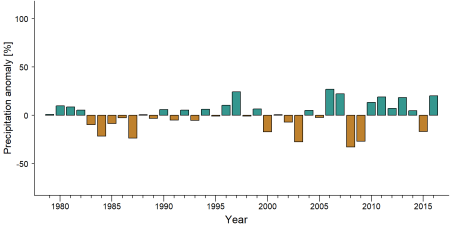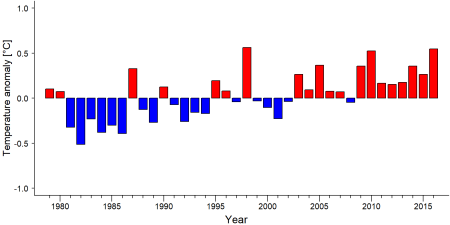Difference between revisions of "Bakossi National Park"
| (One intermediate revision by the same user not shown) | |||
| Line 25: | Line 25: | ||
= Site characteristics = <!-- A paragraph summary of physical and geographic aspects of the site, and a table of key information --> | = Site characteristics = <!-- A paragraph summary of physical and geographic aspects of the site, and a table of key information --> | ||
| − | Bakossi National Park is located in western Cameroon, to the south of the [[Banyang-Mbo Wildlife Sanctuary]] and covers an area of 29,320 ha. The altitude in the park ranges from 300m to | + | Bakossi National Park is located in western Cameroon, to the south of the [[Banyang-Mbo Wildlife Sanctuary]] and covers an area of 29,320 ha. The altitude in the park ranges from 300m to 1895 m above sea level, giving rise to three main vegetation types: sub-montane forest, Atlantic forest of the North West type with semi-deciduous elements, and the Atlantic Biafran forest rich in Caesalpiniaceae. This accounts for the huge floral variety of the area and a high level of endemism, and a corresponding high diversity of fauna species (Enukwa et al. 2022). |
| − | The site is a hotspot for many primate species, including the | + | The site is a hotspot for many primate species, including the drill (''Mandrillus leucophaeus''), one of the most endangered primate species in the world, and the chimpanzee (''Pan troglodytes''). Other primates include Preuss’s red colobus, red-eared guenon, Preuss’s guenon, putty-nosed monkey, mona monkey and other important mammals like blue duikers, red river hog, red-fronted duiker, black-fronted duikers, sitatunga, and long-tailed pangolin ([https://cameroon.panda.org/places_landscapes/coastal_forests_programme/bakossi_national_park/ WWF]). |
The Bakossi forests support several small streams, cascading waterfalls and deep pools, and the Mungo River which flows through the park. Along the way, thousands of people far beyond the site depend on the river for their livelihoods through activities such as fishing, sand extraction, and logs and food transportation ([https://cameroon.panda.org/places_landscapes/coastal_forests_programme/bakossi_national_park/ WWF]). | The Bakossi forests support several small streams, cascading waterfalls and deep pools, and the Mungo River which flows through the park. Along the way, thousands of people far beyond the site depend on the river for their livelihoods through activities such as fishing, sand extraction, and logs and food transportation ([https://cameroon.panda.org/places_landscapes/coastal_forests_programme/bakossi_national_park/ WWF]). | ||
| Line 70: | Line 70: | ||
|Index survey | |Index survey | ||
|Enukwa et al. 2022 | |Enukwa et al. 2022 | ||
| − | |Reconnaissance walk covered a total of 61 km. | + | |Reconnaissance walk covered a total of 61 km. Signs recorded: nests 0.9 per km, and feeding signs 0.3 per km |
| | | | ||
|} | |} | ||
Latest revision as of 02:52, 7 March 2024
Central Africa > Cameroon > Bakossi National Park
Summary
- Nigeria-Cameroon chimpanzees (Pan troglodytes ellioti) are present in Bakossi National Park.
- The population size is unknown.
- The chimpanzee population trend is unknown.
- The site has a total size of 293km².
- Chimpanzees are mainly threatened by hunting.
- Conservation activities are not documented.
- The site is part of the Bakossi Landscape Area.
Site characteristics
Bakossi National Park is located in western Cameroon, to the south of the Banyang-Mbo Wildlife Sanctuary and covers an area of 29,320 ha. The altitude in the park ranges from 300m to 1895 m above sea level, giving rise to three main vegetation types: sub-montane forest, Atlantic forest of the North West type with semi-deciduous elements, and the Atlantic Biafran forest rich in Caesalpiniaceae. This accounts for the huge floral variety of the area and a high level of endemism, and a corresponding high diversity of fauna species (Enukwa et al. 2022). The site is a hotspot for many primate species, including the drill (Mandrillus leucophaeus), one of the most endangered primate species in the world, and the chimpanzee (Pan troglodytes). Other primates include Preuss’s red colobus, red-eared guenon, Preuss’s guenon, putty-nosed monkey, mona monkey and other important mammals like blue duikers, red river hog, red-fronted duiker, black-fronted duikers, sitatunga, and long-tailed pangolin (WWF). The Bakossi forests support several small streams, cascading waterfalls and deep pools, and the Mungo River which flows through the park. Along the way, thousands of people far beyond the site depend on the river for their livelihoods through activities such as fishing, sand extraction, and logs and food transportation (WWF).
Table 1. Basic site information for Bakossi National Park
| Area | 293 km² |
| Coordinates | 5.069109, 9.586158 |
| Designation | National Park |
| Habitat types | Subtropical/tropical moist lowland forest, subtropical/tropical moist montane forest |
IUCN habitat categories Site designations
Ape status
In a survey of the southeastern section of the park, chimpanzees were recorded entirely in the montane forest (Enukwa et al. 2022).
Table 2. Ape population estimates in Bakossi National Park
| Species | Year | Abundance estimate (95% CI) | Density estimate [ind./ km²] (95% CI) | Encounter rate (nests/km) | Area | Method | Source | Comments | A.P.E.S. database ID |
|---|---|---|---|---|---|---|---|---|---|
| Pan troglodytes ellioti | 2022 | 1.2 | Southeast of Bakossi National Park, approx. 12 km2 | Index survey | Enukwa et al. 2022 | Reconnaissance walk covered a total of 61 km. Signs recorded: nests 0.9 per km, and feeding signs 0.3 per km |
Threats
Table 3. Threats to apes in Bakossi National Park
| Category | Specific threats | Threat level | Quantified severity | Description | Year of threat |
|---|---|---|---|---|---|
| 1. Residential & commercial development | Unknown | ||||
| 2. Agriculture & aquaculture | Unknown | ||||
| 3. Energy production & mining | Unknown | ||||
| 4. Transportation & service corridors | 4.1 Roads & railroads | Present, but threat severity unknown | An old, abandoned road along the south-eastern edge of Bakossi is being reopened with European funds (BirdLife International 2023). | Ongoing (2023) | |
| 5. Biological resource use | 5.1 Hunting & collecting terrestrial animals | High | Hunting of large mammals (BirdLife International 2023). | Ongoing (2023) | |
| 6. Human intrusion & disturbance | Unknown | ||||
| 7. Natural system modifications | Unknown | ||||
| 8. Invasive & other problematic species, genes, diseases | Unknown | ||||
| 9. Pollution | Unknown | ||||
| 10. Geological Events | Absent | ||||
| 11. Climate change & severe weather | Unknown | ||||
| 12. Other options | Absent |
Conservation activities
Table 4. Conservation activities in Bakossi National Park
| Category | Specific activity | Description | Year of activity |
|---|---|---|---|
| 1. Residential & commercial development | Not reported | ||
| 2. Agriculture & aquaculture | Not reported | ||
| 3. Energy production & mining | Not reported | ||
| 4. Transportation & service corridors | Not reported | ||
| 5. Biological resource use | Not reported | ||
| 6. Human intrusion & disturbance | Not reported | ||
| 7. Natural system modifications | Not reported | ||
| 8. Invasive & other problematic species, genes, diseases | Not reported | ||
| 9. Pollution | Not reported | ||
| 10. Education & Awareness | Not reported | ||
| 11. Habitat Protection | 11.2. Legally protect primate habitat | The park was established in 2007. | 2007-Ongoing (2023) |
| 12. Species Management | Not reported | ||
| 13. Livelihood; Economic & Other Incentives | Not reported |
Conservation activities list (Junker et al. 2017)
Challenges
Table 5. Challenges reported for Bakossi National Park
| Challenge | Source |
|---|---|
| Not reported |
Research activities
Documented behaviours
Table 6. Ape behaviors reported for Bakossi National Park
| Behavior | Source |
|---|---|
| Not reported |
Exposure to climate change impacts
As part of a study on the exposure of African great ape sites to climate change impacts, Kiribou et al. (2024) extracted climate data and data on projected extreme climate impact events for the site. Climatological characteristics were derived from observation-based climate data provided by the Inter-Sectoral Impact Model Intercomparison Project (ISIMIP, www.isimip.org). Parameters were calculated as the average across each 30-year period. For 1981-2010, the EWEMBI dataset from ISIMIP2a was used. For the two future periods (2021-2050 and 2071-2099) ISIMIP2b climate data based on four CMIP5 global climate models were used. For future projections, two Representative Concentration Pathways (RCP) were used. RCP 2.6 is a scenario with strong mitigation measures in which global temperatures would likely rise below 2°C. RCP 6.0 is a scenario with medium emissions in which global temperatures would likely rise up to 3°C by 2100. For the number of days with heavy precipitation events, the 98th percentile of all precipitation days (>1mm/d) was calculated for the 1979-2013 reference period as a threshold for a heavy precipitation event. Then, for each year, the number of days above that threshold was derived. The figures on temperature and precipitation anomaly show the deviation from the mean temperature and mean precipitation for the 1979-2013 reference period. The estimated exposure to future extreme climate impact events (crop failure, drought, river flood, wildfire, tropical cyclone, and heatwave) is based on a published dataset by Lange et al. 2020 derived from ISIMIP2b data. The same global climate models and RCPs as described above were used. Within each 30-year period, the number of years with an extreme event and the average proportion of the site affected were calculated (Kiribou et al. 2024).
Table 7. Estimated past and projected climatological characteristics in Bakossi National Park
| 1981-2010 | 2021-2050, RCP 2.6 | 2021-2050, RCP 6.0 | 2071-2099, RCP 2.6 | 2071-2099, RCP 6.0 | |
| Mean temperature [°C] | 25.3 | 26.4 | 26.3 | 26.6 | 27.6 |
| Annual precipitation [mm] | 2566 | 2672 | 2686 | 2749 | 2756 |
| Max no. consecutive dry days (per year) | 36.5 | 29.3 | 34.4 | 32.6 | 36 |
| No. days with heavy precipitation (per year) | 6 | 8.2 | 8 | 9 | 8.9 |
Table 8. Projected exposure of apes to extreme climate impact events in Bakossi National Park
| No. of years with event (2021-2050, RCP 2.6) | % of site exposed (2021-2050, RCP 2.6) | No. of years with event (2021-2050, RCP 6.0) | % of site exposed (2021-2050, RCP 6.0) | No. of years with event (2070-2099, RCP 2.6) | % of site exposed (2070-2099, RCP 2.6) | No. of years with event (2070-2099, RCP 6.0) | % of site exposed (2070-2099, RCP 6.0) | |
| Crop failure | 3.5 | 0.33 | 4 | 0 | 0.5 | 0.13 | 5.5 | 0.01 |
| Drought | 0 | 0 | 0 | 0 | 0 | 0 | 0 | 0 |
| Heatwave | 8 | 100 | 7 | 100 | 7.5 | 100 | 10.5 | 100 |
| River flood | 2.5 | 0.7 | 1 | 0.86 | 1.5 | 2.05 | 5 | 1.81 |
| Tropical cyclone | 0 | 0 | 0 | 0 | 0 | 0 | 0 | 0 |
| Wildfire | 30 | 0.63 | 30 | 0.65 | 29 | 0.63 | 29 | 0.66 |
External links
References
Enukwa, E. H., Augustine, M. A., Ndumbe, L. N., & Namuene, K. S. (2022). Cameroon-Nigeria Chimpanzee (Pan troglodytes ellioti Matschie, 1914) distribution and habitat affinities in Bakossi National Park. Journal of Wildlife and Biodiversity, 6(3), 1-11.
BirdLife International (2023) Important Bird Areas factsheet: Bakossi mountains. Downloaded from http://www.birdlife.org on 15/05/2023.
Kiribou, R., Tehoda, P., Chukwu, O., Bempah, G., Kühl, H. S., Ferreira, J., ... & Heinicke, S. (2024). Exposure of African ape sites to climate change impacts. PLOS Climate, 3(2), e0000345.
Page completed by: A.P.E.S. Wiki team Date:13/05/2023

